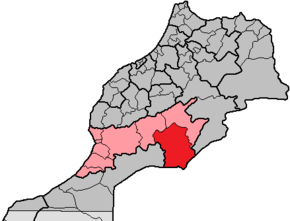Zagora (province)


The approximately 21,000 km² large and about 310,000 inhabitants province of Zagora ( Arabic قليم زاكورة; Central Atlas Tamazight ⵜⴰⵙⴳⴰ ⵏ ⵜⵣⴰⴳⵓⵔⵜ ) is part of the Moroccan region of Drâa-Tafilalet ; until 2015 it belonged to the Souss-Massa-Draâ region . The capital of the province is the city of Zagora .
geography
location
The province of Zagora borders the province of Tata in the west, the province of Ouarzazate in the north-west, the province of Tinghir in the north-east, the province of Errachidia in the south-east and Algeria in the south .
landscape
The landscape is divided into three areas: The 800 to 1000 m high Drâa Valley with its river oases forms the lifeline and main traffic route of the province. To the west and east of it, the eastern foothills of the Anti-Atlas Mountains rise to heights of 1700 m . In the south is the desert-like Sahara foreland , which - apart from the almost 1,100 m high mountain range of Jbel Bani - lies at an altitude of about 700 m .
climate
The climate is usually hot and dry. Daytime temperatures of 45 ° C are not uncommon in summer - in winter it is usually between 25 and 30 ° C; at night, however, it usually cools down to around 5–15 ° C in summer or 0 to 10 ° in winter, depending on the cloudiness.
population
About a third of the province's 250,000 inhabitants live in the three cities of Agdz , Zagora and Mhamid . Two thirds are mainly distributed among the rural communities ( communes rurales ) of the river oases on the Oued Drâa. The mountain regions are hardly populated. Most of the people living here are Berbers ; In addition to Central Atlas Tamazight , Arabic is also spoken .
economy
The traditional oasis economy , the main plant of which is the date palm , has provided people with essential food for centuries (probably even millennia). Animals (sheep, goats, chickens) could no longer run freely in the oases, but had to be kept in stables and fed by people. Because of the great distances, the entire economic structure was geared towards self - sufficiency . Markets and cities did not emerge in the Drâa Valley until the French colonial period . Since the 1970s, tourism in the Drâa Valley has increased more and more every year.
history
Even if hardly any archaeologically usable remains have been preserved - not to mention written evidence - one must assume that the Drâa Valley was one of the first areas in Morocco in which people of earlier times settled down. The river oases provided the people and initially also the animals with everything they needed for life, so that the times of wandering around as hunters and gatherers or as cattle nomads here around 3000 BC. BC, maybe not until 2000 BC. BC found an early end. Barley , millet , field beans and possibly also chickpeas have been grown since ancient times . In the course of time, other plants were brought here from other areas - fig , pomegranate , olive and almond trees as well as prickly pear cacti and grapevines , and later potatoes, tomatoes and other vegetables, came here.
In the sparsely populated mountain regions, the traditional semi-nomadic way of life ( transhumance ) has been preserved to this day.
Attractions
The few archaeological evidence in the Drâa Valley consists of some 4,000 to 6,000 year old rock drawings ( petroglyphs ) with depictions of wild animals that must have lived here - elephants still lived in the north of Africa in Carthaginian times . Significantly more recent (around 500 BC to 500 AD) are the engravings on some steles and rock slabs, which are covered with illegible geometric characters in the so-called "Libyan-Berber script".
literature
- Werner Pichler: Origin and development of the Libyco-Berber Script. R. Köppe Verlag, Cologne 2007, ISBN 978-3-89645-394-5 .
- Arnold Betten: Morocco. Antiquity, Berber Traditions and Islam - History, Art and Culture in the Maghreb. DuMont, Ostfildern 2012, pp. 290ff, ISBN 978-3-7701-3935-4 .
Web links
- Drâa Valley - Photos
- Southern end of the Drâa valley - photo ( memento from 23 August 2013 in the web archive archive.today )
Individual evidence
- ↑ Statistical information on the province of Zagora
- ↑ Population statistics Morocco ( Memento from March 3, 2016 in the Internet Archive )




